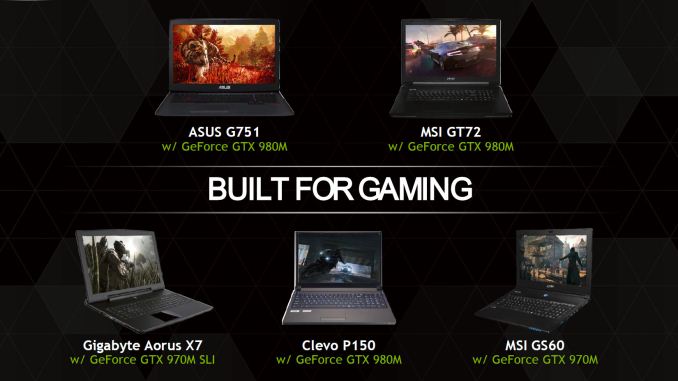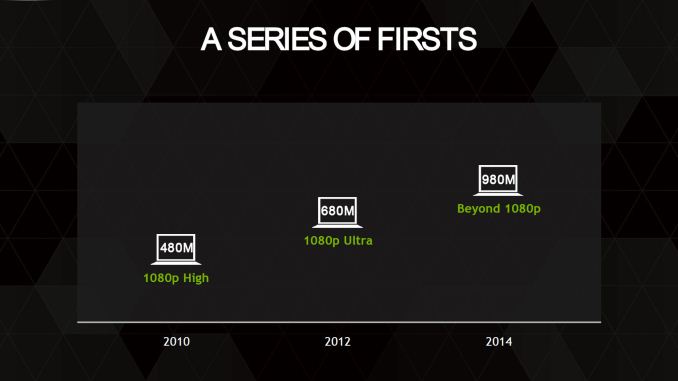NVIDIA GeForce GTX 980M and GTX 970M: Mobile to the Maxwell
by Jarred Walton on October 7, 2014 9:00 AM ESTGTX 980M and 970M Notebooks and Conclusion
Today's launch of 980M and 970M is about as much of a "hard launch" as we see with notebook GPUs. Quite a few notebooks should be available for order with the new chips, though it could take a couple weeks or more for orders to process. We were hoping to have the MSI GT72 prior to today's launch, but as noted earlier it should arrive in the next day (or in a few hours even). We'll post a follow-up Pipeline article as soon as we're able showing performance using some of our standard gaming and graphics benchmarks. In the meantime, here's the current list of notebooks that support the new GPUs.
| Upcoming GeForce GTX 980M/970M Notebooks | |||
| Manufacturer | Model | GPU | Size |
| ASUS | G751 | GeForce GTX 980M GeForce GTX 970M |
17” |
| MSI | GT72 | GeForce GTX 980M GeForce GTX 970M |
17” |
| MSI | GS60 | GeForce GTX 970M | 15” |
| MSI | GS70 | GeForce GTX 970M | 17” |
| Gigabyte | P35 | GeForce GTX 970M | 15” |
| Gigabyte | Aorus X7 | 2x GeForce GTX 970M (SLI) | 17” |
| Clevo | P150/P157 | GeForce GTX 980M GeForce GTX 970M |
15” |
| Clevo | P170/P177 | GeForce GTX 980M GeForce GTX 970M |
17” |
| Clevo | P650 | GeForce GTX 980M GeForce GTX 970M |
15” |
For their part, NVIDIA has provided performance numbers for both GPUs at different settings in a variety of games, but there's no comparison with other GPUs so the numbers are out of context. As a preview of what to expect, and considering several of the games use the built-in benchmark tools, here's what NVIDIA is reporting; all of the following games were tested at 1080p with the settings indicated:
| NVIDIA Performance Results | |||
| Game | Game Settings | GTX 980M | GTX 970M |
| Batman: Arkham Origins | Max, FXAA High, PhysX High | 60 | 45 |
| Battlefield 4 | Ultra | 66 | 49 |
| Bioshock Infinite | Ultra DX11_DDOF | 91 | 69 |
| Crysis 3 | Very High 4xMSAA | 36 | 26 |
| Far Cry 3 | Ultra 4xMSAA | 51 | 38 |
| Hitman Absolution | Ultra | 74 | 65 |
| Metro: Last Light | Very High SSAA | 36 | 27 |
| StarCraft II | Max 4xMSAA | 68 | 62 |
| Tomb Raider | Ultimate | 69 | 51 |
Most of the games are apparently being run at near maximum quality settings (though Batman is missing 4xMSAA, it does have PhysX enabled), which is good for putting as much of the bottleneck on the GPU as possible. StarCraft II and Hitman Absolution appear to be CPU limited, which isn't too surprising for StarCraft II as it has always been heavily influenced by CPU performance. On average, the GTX 980M outperforms the GTX 970M by 28%, even including the CPU limited games; if we ignore StarCraft II and Hitman Absolution the 980M is 34% faster on average.
Update: our own performance preview of GTX 980M is now available. The short summary is that GTX 980M is about the same performance level as the desktop GTX 770, though obviously with some newer features like DX12 support and VXGI. It's also twice as fast as the GTX 860M and 35% faster than GTX 880M on average.
One of the problems we're starting to run into with mobile GPUs getting so fast is that many laptops still top out at a 1920x1080 display, and even at maximum detail there are plenty of games that will easily break 60 FPS and may start running into CPU bottlenecks. For that reason, NVIDIA is billing the GTX 980M as a mobile GPU that targets playable frame rates at resolutions beyond 1080p, and we'll likely see more high-end notebooks ship with 2560x1440, 3K, or even 4K displays. It's probably a bit too much to assume that 3K gaming at 60 FPS will happen on most titles at maximum quality with the 980M, as games like Metro: Last Light and Crysis 3 can be very taxing, but we're definitely getting close to being able to max out settings on most games.
NVIDIA didn't provide specific numbers for their previous generation mobile GPUs, but they do note that GTX 980M should be around 40% faster than the GTX 880M, which is no mean feat. Compared to the first generation Kepler GPU, GTX 680M, the difference is even larger: 980M is roughly twice as fast as the GTX 680M that launched three years ago. GTX 970M is also supposed to be about 40% faster than the previous generation GTX 870M and on average twice as fast as the GTX 860M.
Wrapping up, we've provided a full gallery of slides from the NVIDIA presentation for those that are interested. We're very much looking forward to some hands on time testing out the GTX 980M, as it should prove to be quite a formidable GPU. That's not too surprising as GM204 proved to be quite potent on desktop GPUs, with a smaller and more efficient chip able to basically match and generally exceed the performance of l the larger and more power hungry GTX 780 Ti. The result is that this is as close as notebooks have come to matching desktop performance (for a single GPU) in as long as I've been reviewing notebooks.
Looking forward, performance is always improving and we'll certainly see even faster GPUs in the next year. We also know that NVIDIA is capable of making larger GPUs, so we're still missing the true "Big Maxwell" (i.e. GM200 or GM210). As with the GF110 and GK110 I don't expect we'll ever see that chip in consumer notebooks, but we might see GM204 return with even more SMMs enabled. But until NVIDIA comes out with an even bigger and faster Maxwell variant, this is the top mobile GPU, and that means it will priced as such.
We should see GTX 980M in gaming notebooks starting around the $2000 price point (give or take), with GTX 970M launching in notebooks starting at $1600. Based on MSI's pricing of their GT72, it also looks like the GTX 980M may have as much as a $350 price premium over the GTX 970M, or at least that's the difference in pricing for end users. (Ouch.) We're covering the notebooks that have been announced in separate Pipeline articles, and we should see some of them at the usual places like Newegg and Amazon. Stay tuned for our performance results from the MSI GT72, which will go up as soon as we get the laptop and can run some tests.






























68 Comments
View All Comments
chizow - Tuesday, October 7, 2014 - link
To finish the thought, I would be a lot more open to something like a Shield Tablet or Portable and use the remote GameStream feature to remotely play games on my PC, but of course that is hit or miss depending on the quality of connection where I am travelling.JarredWalton - Tuesday, October 7, 2014 - link
Heh, the market research is from NVIDIA, who is in turn citing... I'm not entirely sure. And keep in mind that when NVIDIA moved the 850 series from the GT to the GTX line, they inherently gave "gaming notebooks" a much larger piece of the pie. I also have to say that Optimus has helped a lot with the sales of gaming notebooks, as there's less need to compromise these days. Then toss in some nice designs like those from Razer and gaming notebooks can even be sleek and sexy as opposed to big and boxy.I have no doubt NVIDIA is selling more GPUs for gaming notebooks today than three years ago, and perhaps it's even 5X as many, but certainly a big part of the increase comes from the plateau in gaming requirements. If you're willing to turn off AA (especially SSAA) and run at High detail instead of Ultra, a very large percentage of games run quite well on anything above GTX 670M (or equivalent). Will we continue to see that sort of sales growth for the next three years? Probably not.
chizow - Tuesday, October 7, 2014 - link
Ah ok that makes sense, Nvidia does tend to throw out some interesting figures and given they are on the supply end of things, that can make their counts pretty accurate (ex: Jensen Huang revealed during his Game24 keynote GTX 680 sold ~10m units). They also have the deep pockets to pay for the research from firms like JPR, Mercury Research, Gartner etc.But I guess you are right as well regarding a lot entrants into this market. About a decade ago it was just Alienware and FalconNW, then it was CyberPower, iBuyPower etc, then the big Taiwanese OEMS got into the game and now you have gaming centric companies like Razer breaking into the market. They are all obviously going after a pie that is getting bigger or they wouldn't bother.
Looking forward to the test results, but again, for my own current usage patterns I can't see myself buying a gaming notebook. When I travel now its usually local, short-term or all business and I carry my work Dell Ultrabook or Surface Pro 3, no time for gaming. Competent laptop gaming would be interesting though for a student or business traveler that travels for most of the week or 50%+.
jtd871 - Tuesday, October 7, 2014 - link
Where these could really shine is in SFF/Brix/NUC-like units, especially if the thermals and prices are reasonable. Steamboxen, anyone?chizow - Tuesday, October 7, 2014 - link
Yeah absolutely, but for Steamboxes you can already go with a full-sized GTX 970/980 (if you can find one!). But yes these would go great in a BRIX unit, although I personally think the BRIX units with GTX 760 were asking a little bit too much (like $700 I think?).nathanddrews - Tuesday, October 7, 2014 - link
Where are the integrated G-Sync laptops? Seems like a PRIME market for such a technology. We're already talking high-end prices, so what's another $100-200 for something that mobile GPUs most definitely need?BigT383 - Tuesday, October 7, 2014 - link
+1. I was wondering this as well- As a laptop manufacturer, when you're selling the display and the GPU as a single unit it seems like it would be even easier to support the G-Sync technology.Kevin G - Tuesday, October 7, 2014 - link
This would be an interesting development and something a premium manufacturer could use to justify their premium price and/or differentiate from themselves from the crowd.I suspect there isn't room for the the additional circuitry used in G-sync displays. There is also the power factor which isn't great has to be accounted for in a notebook vs. stand alone monitor.
Basically until nVidia fully integrates their G-Sync technology into a chip, I'd be surprised to see it in a laptop.
chizow - Tuesday, October 7, 2014 - link
Yeah, the module and heatsink probably could not be easily integrated into a laptop chassis and the premium on G-Sync is still pretty high at $150-200 over comparable non-G-Sync module. Add to that the possibility some users might choose to dock the laptop to a TV or bigger display and you'd lose G-sync functionality.nathanddrews - Tuesday, October 7, 2014 - link
Not if you connect to a G-Sync display using DP (assuming the notebooks have DP out).